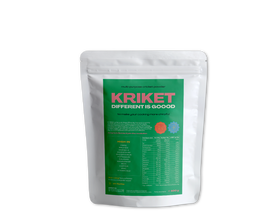Why crickets?
“Why crickets?” you may ask. “Why not?” seems like a more suitable question. Missing out on an abundance of natural antioxidants, protein, fibre, vitamin B12, iron and zinc would be a noticeable waste.
Better brain and gut function while boosting your bone health and reducing fatigue? Well, we’re all for it. Crickets have been proven to contain double the amount of protein than beef, while holding on to 7 times more vitamin B12 than salmon, minus all the microplastics that float around in our oceans, of course.
Currently, insects feed about 2 billion people each day in African, Asian and Latin American countries. People have been consuming insects for ages and they have become a crucial part of many diets around the world. In some places, they are treated as a delicacy, and rightly so!
It’s time to see crickets for what they truly are and enjoy all their astounding benefits.
Protein
Proteins are the building blocks of our body. They are present in every single cell in your muscles, bones, brain, skin, hair and nails. Luckily, crickets are literally bursting with protein!
However, it’s not only the amount of protein that makes a difference for our health – but rather the quality of protein. Proteins consist of amino acids. Out of 20 amino acids, 9 of them are essential. This means our body cannot produce them and thus need to be sustained via food.
Nutritionists agree that animal-based foods tend to be good sources of complete proteins, while plant-based foods (grains, beans, pulses, nuts and seeds) often lack one or more essential amino acids. Also, it seems animal-based protein triggers the muscle (re)building process more efficiently.
"What does this have to do with insects?" you may ask? Here’s the catch. Crickets contain all 9 essential amino acids and have a protein level twice as high as beef, combined with an environmental impact similar to plant-based proteins. Best of both worlds, one could say. Even within the insect kingdom, crickets are the star of the show with 63% of pure complete protein, compared to 46% for mealworms and 20% for grasshoppers.

Vitamin B12
Don’t you just love it when your brain and nervous system function properly? Well, obviously! Vitamin B12 takes a crucial part in that. It is also involved in the formation of red blood cells, which carry oxygen to all the different parts of our body. Other than that, vitamin B12 helps to create and regulate our DNA. A healthy dose of vitamin B12 ensures not only better energy levels and digestion, but also intervenes in regulating your mood. But... plot twist: our body doesn’t make vitamin B12.
Wait, what? Don’t fear, we've got you covered: crickets are B12 powerhouses!
Getting a healthy dose of vitamin B12 is key, especially if you are trying to reduce your meat consumption. Unless artificially added, plant-based foods don't contain vitamin B12.

Sooo much more
And as if that wasn’t enough, crickets got you covered for your Omega-3 supply, iron, manganese, zinc, phosphorus, ... The list just goes on and on.
In the table below you can discover the % of recommended daily intake you get per tablespoon of 15 g of cricket powder.
You might have heard already: our food system is causing great damage to our planet. It’s degrading our soils and polluting both water and air. At the same time, we’re wasting 30% of all foods that are produced globally.
Climate change, loss of biodiversity and population growth are pushing humankind (you!) to reinvent itself in order to keep on living in harmony with nature.
The elephant in the room? It's rather looking like a cow, a pig or a chicken. 80% of all agricultural land is dedicated to the production of feed for livestock, which is expected to double by 2050. So, you get the picture: unless we start growing our food on a Planet B, somewhere in the galaxy, we better switch up the way we grow, share and consume our food. Let’s redesign our food system and focus on small solutions with a big impact. Chiiirp!
Greenhouse gas emissions
To use the words of Barack Obama: “No challenge poses a greater threat to our future generations than climate change.” Back in the 1980s, scientists discovered that human-caused warming had already measurably affected global climate. Today, there is no time to waste if we want to safeguard our planet for future generations. To mitigate the risk, we need to reduce our greenhouse gas (GHG) emissions.
Thanks to climate science, we know that livestock rearing is responsible for 18% of global GHG emissions, a higher share than the transportation sector. Crazy, right?
The good news? Crickets emit much fewer GHG emissions than livestock and don’t emit any methane at all. Did you know that 1 ton of methane corresponds to 25 tons of CO2?!
Source: Oonincx, D. G., Van Itterbeeck, J., Heetkamp, M. J., Van Den Brand, H., Van Loon, J. J., & Van Huis, A. (2010). An exploration on greenhouse gas and ammonia production by insect species suitable for animal or human consumption. PloS one, 5(12), e14445.
Water Use
Could you imagine water becoming the new gold? Well, today already 3.2 billion people live in agricultural areas with high or very high water shortages or scarcity. This number will only increase with the impact of climate change.
BREAKING: saving water by showering instead of taking a bath is not enough anymore. We should also start looking at other aspects of our lives to decrease our water footprint.
Consuming crickets can help you to achieve just that. They require significantly less water than livestock rearing.
Sources:
Van Huis, A., Van Itterbeeck, J., Klunder, H., Mertens, E., Halloran, A., Muir, G., & Vantomme, P. (2013). Edible insects: future prospects for food and feed security (No. 171). Food and Agriculture Organization of the United Nations.
Mekonnen, M. M., & Gerbens-Leenes, W. (2020). The water footprint of global food production. Water, 12(10), 2696.
Feed Conversion
Crickets have a very high feed conversion efficiency (an animal’s capacity to convert feed mass into increased body mass, represented as kg of feed per kg of weight gain).
That’s great news! It means crickets are super-efficient in growing, meaning far less feed is needed to get the same amount of food.
Source: Van Huis, A., Van Itterbeeck, J., Klunder, H., Mertens, E., Halloran, A., Muir, G., & Vantomme, P. (2013). Edible insects: future prospects for food and feed security (No. 171). Food and Agriculture Organization of the United Nations.
Edibility
Unlike most animals, almost all parts of a cricket can be eaten. More deliciousness and less waste, how cool is that?
Source: Van Huis, A., Van Itterbeeck, J., Klunder, H., Mertens, E., Halloran, A., Muir, G., & Vantomme, P. (2013). Edible insects: future prospects for food and feed security (No. 171). Food and Agriculture Organization of the United Nations.
Circular Economy
Crickets are circular champions!
Research from the Ellen MacArthur Foundation shows that, for every dollar spent on food, society pays two dollars in health, environmental, and economic costs. Also, currently 25–30% of total food produced is lost or wasted.
How do we move away from today's linear 'take - make - dispose' economic model? How do we fix this broken food system?
In a circular economy, food leftovers are transformed into a broad array of valuable materials, driving new value chains in a thriving bioeconomy. In this vision, food production improves, rather than degrades, the environment.
Guess what? Crickets can be grown in urban farms on organic side streams from the food industry. They help prevent valuable nutrients from being wasted and play a key role in the local circular economy.



